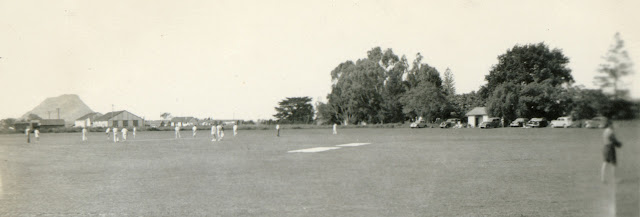One of Tauranga's First English-style Gardens
 |
| A view of Brown's garden from the south c1897 Cabinet card photograph by Thomas E. Price, Tauranga |
Alfred Nesbit Brown (1803-1884) was one of Tauranga’s first European residents who helped establish the Church Mission Society Te Papa Station in the 1830s. It is obvious from entries in his journal that along with organising temporary shelter for his and other missionary families, a high priority was to set out a garden with specimen trees and crops of fruit, berries, vegetables, nuts and grains.
 |
| The Archdeacon's Sentinels in the 1960s |
Their home was what is now known as The Elms and in the grounds there are still at least 5 large trees planted by him in the early 19th Century. Seed from Norfolk pines was reputedly obtained in Sydney on their voyage out and two young trees were planted in such a way as to become navigational aids for ships entering the Tauranga Harbour. Later they were known as the Archdeacon’s Sentinels and appeared on Admiralty charts into the 20th Century.
 |
| Spring view of Brown's 190 year-old oak |
Acorns were brought from “home” in England and a young oak grown during the Brown’s years in the Bay of Islands was transplanted to a corner of the garden in what was to become their permanent home for nearly 50 years. It is now a magnificent tree of almost 200 years and the size of many much older back in the old country.
At some time later an English chestnut was introduced, maybe as a food source, and there are presently three large specimens in this 5 star-rated garden of national significance.
 |
| A garden fete under the Bunya pine, c 1900 |
It became very desirable to plant exotic symmetrical pines in Victorian times and therefore a Bunya pine from Queensland was a valuable addition to Alfred’s growing arboretum. It still continues to grow taller even though it has now been there on the front lawn for over 150 years.
Apart from mostly deciduous trees which also included many elms, some ash and Stone pines a lot of time and energy was expended on food-bearing plants. From writings by Brown and his various houseguests, we can build up a picture of the tremendous variety of plantings and crops that were established.
 |
| The chestut to the left, a young elm to the right |
There were various nut trees, apart from the chestnut, walnuts, hazelnuts and almonds. Fruit trees included a Kentish cherry, a peach orchard and many apples including their son Marsh’s crabapple. Hedges were hawthorne, elderberry and gorse. Vines included grapes, passionfruit, and melons. There were all types of berries including blackcurrants. The many vegetables included potatoes, kumara, pumpkins, turnips and carrots. There were six acres of wheat and corn was also cultivated. The flower gardens included many roses, aloes, sweet peas and bulbs.
All in all it was obviously an amazing place and undoubtedly a huge effort not only by Brown and his family but also many other people living at or associated with Te Papa. If you have never taken a trip to The Elms/Te Papa, I can recommend it as a lovely place to spend time at: elms.org.nz
Sources
Garden booklet prepared by Elms Guide Beverley Corbett (unpublished)
The Elms garden image collection












